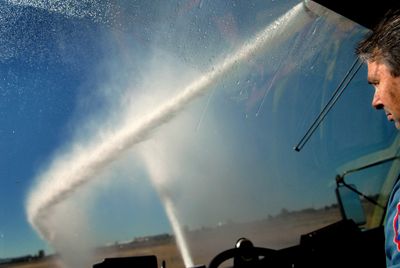Airport adds second high-capacity firetruck

A firetruck capable of extinguishing large amounts of burning jet fuel has arrived.
Spokane International Airport took delivery earlier this summer of a Rosenbauer Panther firetruck that can spray 2,500 gallons of foam retardant a minute.
It replaces a smaller truck purchased in 1987 and increases the airport’s firefighting capacity in the event of a plane crash.
The new truck carries an onboard capacity of 3,000 gallons and can reach a crash scene at a speed of up to 80 mph. In addition to its foam system, the fire engine carries dry powder and halon. Fire Chief Bruce Millsap said the new truck – which cost $700,000 — will improve the chances that airport firefighters can create a safe exit path for survivors in a crash.
“You are buying survivability for people who are still on board the aircraft,” he said.
While the department can expect to respond to 30 or more aircraft standby calls a year – often the result of faulty indicator lights – most of the department’s readiness is intended for when something really goes wrong.
The FAA requires airport fire departments to maintain two fire engines with an onboard total of 3,000 gallons of foam for putting out fuel fires.
Spokane International now has three engines – two with 3,000 gallons and one with 1,500 gallons. The engine being replaced had 1,500 gallons on board.
The trucks are designed to mix water and a foaming agent to instantly shoot aqueous film-forming foam, known as AFFF, on a jet fuel fire. The foam lies on top of the fuel, preventing vapors from escaping and burning, Millsap said. The new airport firetruck was supplied through General Fire Equipment Co., of Spokane.
“It’s one of those trucks you don’t see every day,” said Joe Speranzi, of General Fire. “AFFF is the kryptonite.”
The effectiveness of the system was demonstrated a year ago when the airport fire department sent its older 3,000-gallon foam truck to a raging fire at Whitley Fuel in northeast Spokane. Within minutes, the truck crew knocked down the blaze and after 25 minutes had essentially stopped the fire, Millsap said.
The airport foam truck had responded under an intergovernmental agreement for mutual aid.
Todd Woodard, spokesman for the airport, underlined the significance of the mutual aid agreement by pointing out that the city fire department and a nearby county fire department would almost certainly be needed in the event of an aircraft disaster.
‘Mini-milestone’
Washington transportation officials last week reported that construction of a railroad tunnel along the route of a new North Spokane freeway is nearly completed, a “mini-milestone,” according to one transportation engineer.
Now contractors will be able to back-fill on top of the tunnel and continue work on the first “driveable” leg of the route to connect the northern parts of Spokane with Interstate 90. The work sets the stage for completion in 2009 of the segment from Farwell Road south to the vicinity of Freya Street and Francis Avenue.
Paving is under way near Farwell Road. Other work is being done at various points along the route.
I-90 drains cleaned
The state is also warning drivers on I-90 in Spokane to be careful on the freeway during daytime hours this week. Crews are going to be cleaning storm drains between the Latah Creek Bridge and Argonne Road from 9 a.m. to 3:30 p.m. each day. Sections of inside lanes in both directions will be closed a various times.
Elsewhere on I-90, pavement repairs are under way on seven segments in a 43-mile stretch through Adams, Lincoln and Spokane counties, said Al Gilson, DOT spokesman.
Paving work
Now that work on the Maple Street Bridge and Maple Street north of the Spokane River is completed, city officials warn drivers to watch out for intermittent lane closures as crews install finishing touches on the newly paved northbound arterial. In addition:
•Neighborhood paving in the vicinity of Third and Fourth avenues in the East Central Neighborhood is continuing this week.
•Work on Driscoll Boulevard has caused that arterial to be closed, although main intersections along the route are being kept open so that residents can get through the work area.
•The intersection of Hamilton Street and Mission Avenue will be closed on Tuesday and Wednesday from 6 a.m. to 4 p.m. to complete the restoration of pavement on Hamilton. Detours will be provided, but traffic congestion could occur as a result of the closures.
•Also, Northwest Boulevard from Assembly to Alberta streets will have crack-sealing repair work this week.
•Second Avenue near Post Street will be half closed on Friday for water and sewer work.
Mullan work to begin
In Post Falls, paving is set to start today on Mullan Avenue from Idaho Street to Highway 41. Reduced speeds and occasional delays can be expected. For more information, visit www.postfallsidaho.org.